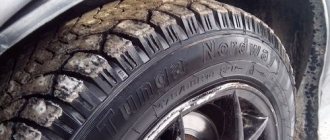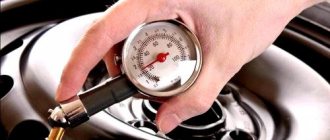Modern cars with internal combustion engines use a closed liquid cooling system. In most cases, antifreeze circulates inside the system. Although some stubbornly continue to pour ordinary water into it, which is a gross violation of the operating rules.
A constant excess pressure is created inside this system while the engine is running. Not everyone understands why this is necessary, since the main task is to ensure efficient circulation of the cooling fluid in small and large circles.
In fact, pressure plays a big role in the operation of the internal combustion engine. It allowed us to get rid of a common and very pressing problem with old cars.
Why is internal pressure created?
Having dealt with the pressure in the engine cooling system, much will become clear and obvious.
There is an example of old cars. In them, the liquid continuously circulated in the motor, heated up, taking away excess heat, and then cooled in the radiator due to the counter flow of air and air from a forced fan.
Then ordinary water was poured into the radiator, and the car drove smoothly. But it often happened that the driver was forced to stop in the middle of the road, because thick white steam began to pour out from under the hood. The engine simply began to boil, and the water began to boil and actively evaporate. This is what provoked the appearance of thick white smoke (steam).
To continue the journey, I had to cool the internal combustion engine, fill in new cold water and drive off. At that time, the concept of engine boiling was familiar to almost every car owner.
You will soon understand why the cooling system of a modern engine requires pressure. The reason for boiling of old internal combustion engines is extremely simple. Water under normal conditions at normal atmospheric pressure boils when the temperature reaches 100 degrees Celsius. Circulating in a circle, with a heavy load on the motor, the water does not have time to cool down, and therefore boils.
In modern antifreezes poured into cars, the boiling point has increased to 105-115 degrees Celsius.
Now remember your school physics course, and it will immediately become clear why you really need to create pressure in the cooling system. As the pressure increases, the boiling point of the corresponding liquid also increases.
As the pressure inside the system increases, the antifreeze will boil at a correspondingly higher temperature.
This significantly protects the motors from the boiling effect. Most engines under normal conditions heat up to a temperature of 90-95 degrees Celsius during operation. Using ordinary water and without pressure inside the system, literally with a slight overload the motor would boil. And since antifreeze is poured in, plus the boiling point has increased due to the pressure created, the boiling threshold is pushed back to about 110-120 degrees Celsius. This allows you to eliminate the occurrence of problems even under heavy loads on the internal combustion engine.
And in order to create the required level of pressure in the system itself, there was no need to develop any special technologies. For this purpose, closed cooling systems are used. The liquid in them gradually heats up as the engine operates, steam is formed, and it creates the same pressure.
Pressure cannot increase indefinitely, but it also cannot fall below a certain level. To control these parameters, valve covers are used on the radiator and expansion tank.
The cap allows you to release or build up pressure as needed. This is a compact, but very useful and important device that works for the benefit of the cooling system and the entire engine.
Original spare parts
Very often, high pressure in the engine cooling system is formed due to a malfunction of the air valve, we have already dealt with this. Another thing is that this valve has an insufficient resource, or even a new one may not work. This also applies to other elements of the cooling system, such as a thermostat, water pump, pipes, sensors, radiators, etc. To sleep peacefully, it is better to get the original, the service life of which is often quite long. Of course, such spare parts cost several times more, but they almost 100% guarantee the proper operation of the unit as a whole. After all, the failure of such a seemingly insignificant element as a cover can lead to a major overhaul of the engine.
As for Chinese components, this is a lottery. Some of them can be quite high quality, while others do not travel even 100 kilometers. It’s better not to take risks, because the stingy pays twice.
Normal parameters
It is difficult to say unambiguously what pressure should be in the cooling system of each car. Even on the same model with different installed internal combustion engines, the parameters may differ.
If we talk about average values, then this range is from 1.2 to 2 atmospheres. Although it is extremely rare that the indicators reach 2 atmospheres. But in the automotive industry there is an example when a pressure of 2.2 is considered the norm.
When calculating fluid pressure, the unit of measurement is usually Bars. But they are analogous to atmospheres. That is, 1 atm = 1 bar.
The internal pressure in an automobile cooling system depends on a number of factors. And not the least important role is played by what kind of coolant is poured into the radiator, what design the car’s engine has, its tightness and other nuances.
You can find out accurate information regarding the pressure level specifically in your engine from the manual and operating recommendations from the car manufacturer.
Coolant
The manufacturer recommends using exclusively antifreeze as a coolant for the VAZ 2107. For the uninitiated car enthusiast, antifreeze and antifreeze are one and the same thing. Antifreeze is usually called all coolants without exception, regardless of where and when they were produced. Antifreeze is a type of antifreeze produced in the USSR. The name is an abbreviation for “separate laboratory organic synthesis technology.” Without exception, all coolants contain ethylene glycol and water. The differences are only in the type and quantity of anti-corrosion, anti-cavitation and anti-foam additives added. Therefore, for the VAZ 2107 the name of the coolant is not of great importance.
How is blood pressure checked?
Quite often, motorists are interested in how to check the current pressure in the cooling system in a garage. This is not so easy to do.
For such tasks, special stands are usually used in a car service center, and complex diagnostics are carried out in different operating modes. Approximate indicators can be determined by connecting a pressure gauge to a sealed system. But such manipulations should not be carried out in a garage and without specialized equipment.
Typically, a self-check involves diagnosing the valve cover of the expansion tank. It needs to be checked for integrity, make sure there are no cracks or damage, examine the condition of the seals, etc.
There is also an alternative verification option. To do this, you will need a pressure gauge, pump or compressor. The upper pipe is removed from the expansion tank, and a hose connected to the pump is connected in its place. Pressure is created. When the peak value is reached (usually about 1.4-1.5 atm), the valve should operate.
Valve performance check
Until the antifreeze heats up, the ball inside the lid closes the bottom hole, while the top one remains open. This is necessary for the flow of air from the atmosphere and rapid heating of the coolant. I would like to note that it is periodically necessary to check the functionality of the lid. After all, it often happens that it gets wedged in one of the positions. Because of this, the engine either takes a long time to warm up or does not hold pressure.
Checking the cap of the expansion tank of the VAZ-2110 is extremely simple. To do this, just unscrew it and shake it. If you can hear the ball dangling inside the housing, then the system is working and it is not jammed. Excessive pressure in the engine cooling system, as noted above, can lead to fatal consequences. Therefore, on modern cars the cover has two valves: inlet and outlet. Nowadays you can find lids on sale that operate at a certain pressure. But it is strongly recommended not to change the parameters set by the manufacturer.
The role of the valve cover
Not everyone understands how important a role is played by a seemingly ordinary cap that closes the expansion tank for filling the coolant.
In fact, it is a complex device. Modern lids are equipped with two valves at once. These are exhaust (steam) and inlet. They are also called bypass and atmospheric, respectively.
In fact, this is a special valve that is responsible for the pressure inside the system in question. As the internal temperature rises as the engine heats up, the pressure also rises. If at some point the excess is not dumped, then the seal will be at risk. Elements can simply tear apart from the inside. Usually it all starts with damage to the most vulnerable elements in the form of seals and seals. A rupture of the expansion tank itself, hoses and pipes cannot be ruled out.
The valve cover directly on the expansion tank helps to remove excess pressure and pump it in as needed.
Each valve has a certain response threshold. Its mechanism is designed in such a way that when a certain value is reached, it opens or closes. This relieves excess pressure or sucks in atmospheric air.
When parked for a long time, the engine cools down, the liquid cools, which causes a rarefied atmosphere to form inside. This indicates insufficient pressure inside. To compensate, the valve cover opens and air is sucked in. Thus, the pressure is normalized.
Tags
in the cooling systemcooling system.cooling system canin the cooling system cooling systemflush the cooling system cooling systemcooling system cooling system cooling system fast engine cooling system.equipped with engines internalthis engine is equipped with engine cooling.started the engine of your engine output from the engine itself quick cooling of the engine ZMZ the boiling point increases the solution boiling temperature engine temperature sensor as a result of thermal expansion. normal temperature balance increase the boiling point increase the response temperature
boilingwaterarticledegreesbeginsits celsius
What causes excess pressure
The problem of excess pressure in engine cooling systems has not completely disappeared, despite the introduction of new technologies. That is, the engine can still boil.
It is too much pressure and forced pressure on the internal walls that provoke all sorts of problems, including boiling. To prevent a malfunction in your engine cooling system, you need to quickly solve the problem.
You won’t have to look long for the reasons why there is excessively high pressure in the cooling system of a modern engine. You need to look for it in the steam-air valve mounted on the cover of the expansion tank used to fill the cooling liquid.
Sometimes the reasons lie in the expansion tank itself, which becomes jammed or clogged. But mostly the culprit is obvious. It is because of its loss of performance that too much pressure arises inside the engine, and this can greatly harm the cooling system.
The most correct solution in such a situation would be to replace the cover. There is simply no alternative. But since the valve cover is inexpensive, the car owner will definitely not go broke buying and replacing it.
Some people try to restore the valve when it is stuck due to contamination. For flushing, use liquid to clean carburetors. If this does not help and the increased pressure continues to persist in the cooling system, it will be better for your engine to purchase a new similar cap. Otherwise, don’t be surprised later why the engine boiled, the tank ruptured and serious and expensive repairs were required.
To maintain optimal operating condition of the cooling system, it is recommended to replace the valve cover every 2 years.
Excessive blood pressure is considered a more dangerous phenomenon than its deficiency. But even in this case there are some threats.
System leakage
An even more popular problem among motorists is lack of pressure. This may happen due to:
- stuck air valve;
- presence of leaks in the cooling system.
Accordingly, identifying the problem will not be difficult. The first thing you can do is look at the antifreeze level on a cold engine. If it does not change from trip to trip, then there are no leaks in the system. The second step is to replace the air valve with a new one. After this, the pressure should normalize and the antifreeze will not overheat. Very often, increased pressure in the engine cooling system causes it to then drop. This is partly due to the wedging valve. Sometimes it works, sometimes it doesn't. As a result, pressure builds up, which can cause a leak to form in a weak spot, and then the seal disappears.
Reasons for lack of pressure
It even happens that there is no pressure in the cooling system, which can also cause certain troubles.
There are probable reasons for this situation. They consist in violating the tightness of the system. This will require special equipment to find the problem area. Although sometimes in garage conditions ordinary folk methods are used. By visually searching for the breakdown location, it is sometimes possible to find the area where the depressurization occurred.
First, the condition of the air valve is checked. If it hangs in the open position, the pressure in the system will not increase. Hence the boiling of the engine and its overheating.
If the valve is working normally, then there is a leak in the system. It needs to be found and eliminated. Sometimes antifreeze comes out through damaged pipes and hoses. A worn-out cooling radiator or heater core could also be the cause. The most unpleasant moment is when antifreeze enters the engine. The culprit is a broken cylinder head gasket.
You can also check the system for leaks in a garage. To do this, you need to remove the upper pipe from the expansion tank, and in its place connect a hose with a pump and a pressure gauge. The pump can be replaced with a compressor. Next, begin to build up pressure and watch where the antifreeze will flow from.
Serious consequences
We have already discussed that pressure is created in the engine cooling system. It's quite normal. Another thing is that very often there is a malfunction that is extremely difficult to determine. For example, the antifreeze goes away, but there is no visible leak. In this case, it is quite possible for coolant to enter the engine crankcase. It is recommended to check the oil level regularly. If the coolant actually goes into the engine, the level will increase. Most likely, this indicates a broken cylinder head gasket, changing which is tantamount to rebuilding the power unit.
Any part has its own specific resource, upon reaching which there is no guarantee that it will continue to work properly. There are often cases when even a new expansion tank cap turns out to be inoperative. And now we are not talking about Chinese spare parts, but about original ones. Unfortunately, there is no escape from this.
Tips and tricks
So, if during the operation of the vehicle it was noticed that antifreeze is being squeezed out in some place, a common cause is excess pressure in the engine cooling system. Moreover, if there is no obvious antifreeze leak, then the diagnosis must begin with the expansion tank cap.
Especially often, problems with the lid manifest themselves in such a way that antifreeze or antifreeze is squeezed out from under the lid itself (both during operation of a hot internal combustion engine and after the power plant has cooled down). Another common situation is when, as a result of a pressure failure in the system, some pipes or hoses break.
Finally, we note that air leaks in the cooling system, as well as the ingress of gases from the combustion chamber into the expansion tank, are quite common malfunctions that also impair the performance of the liquid cooling system and often cause a decrease in the coolant level and engine overheating.
As a rule, the seal is broken due to insufficiently tightened clamps on the pipes, cracks in hoses and pipes, etc. lead to the fact that the operating pressure in the cooling system decreases and the antifreeze begins to boil. This is often accompanied by bubbling in the expansion tank.
If gases from the cylinders enter the system, a critical increase in pressure often occurs, as a result of which antifreeze or antifreeze presses, the pipes or radiator can simply rupture. In this case, a common cause is a broken cylinder head gasket, cracks in the block itself or the cylinder head.
- How to bleed the engine cooling system
Causes of air in the car engine cooling system and symptoms. How to remove an air lock from the cooling system, tips and tricks. Read more
- Seething in the expansion tank: causes and diagnosis
Antifreeze boils and bubbles in the expansion tank. Causes of antifreeze or antifreeze boiling, main faults, troubleshooting, recommendations. Read more
- Signs of engine overheating
How to understand that the engine has begun to overheat: obvious and hidden signs of engine overheating. Common reasons why overheating occurs. Read more
- Antifreeze in the engine cylinder block: causes and methods...
Why do antifreeze or antifreeze enter the engine cylinders and what to do in such a situation. How to determine the presence of antifreeze in the cylinders yourself, repair methods. Read more
- How to fix an antifreeze leak: causes and possible...
Reasons why coolant starts to leak. How to find the location of an antifreeze or antifreeze leak yourself. Useful tips and tricks. Read more
- The engine is heating up, the radiator is cold: what is the reason?
Why does the engine overheat or boil while the cooling radiator is cold? Signs of engine overheating, how to prevent serious consequences. Read more











